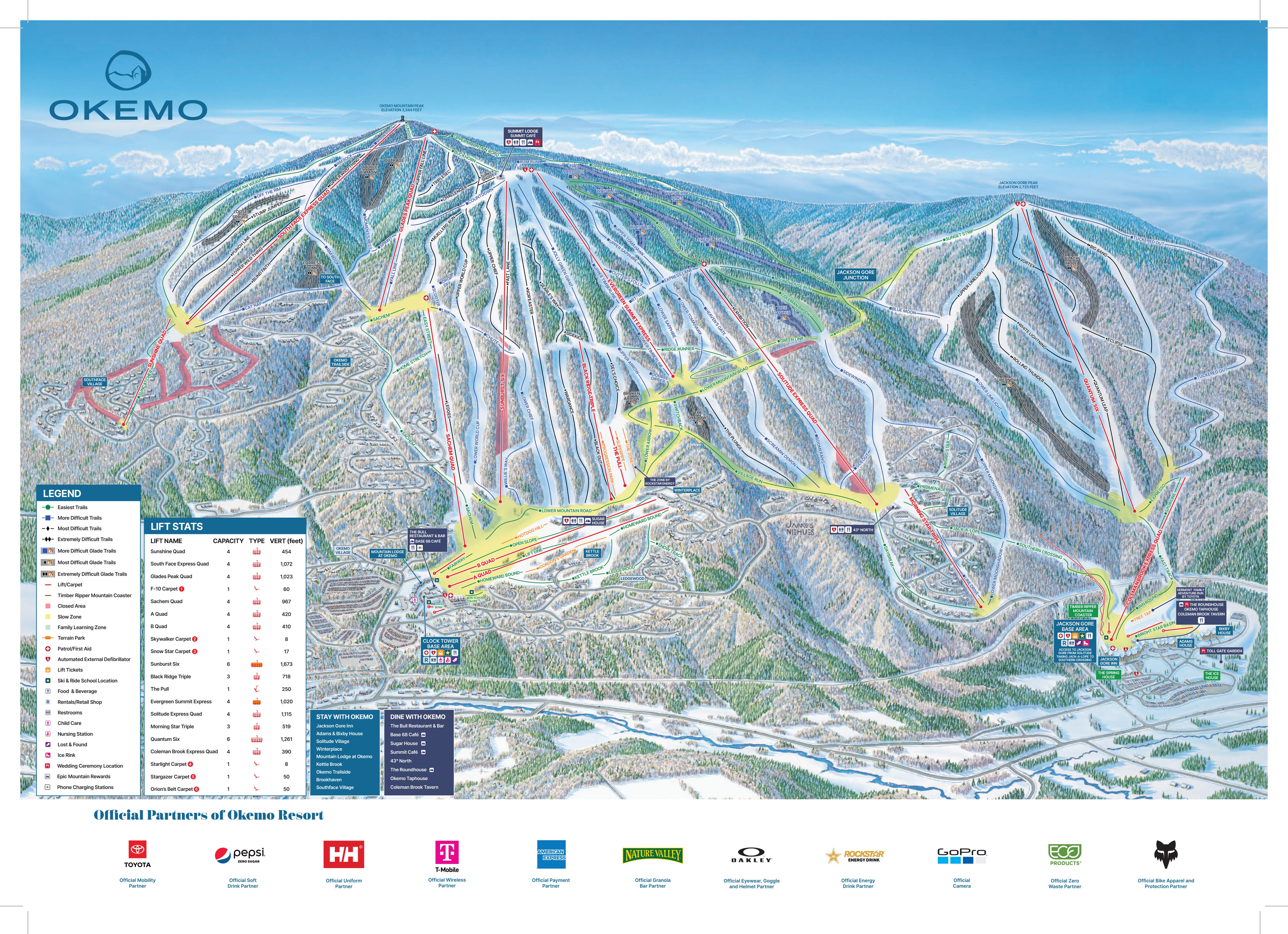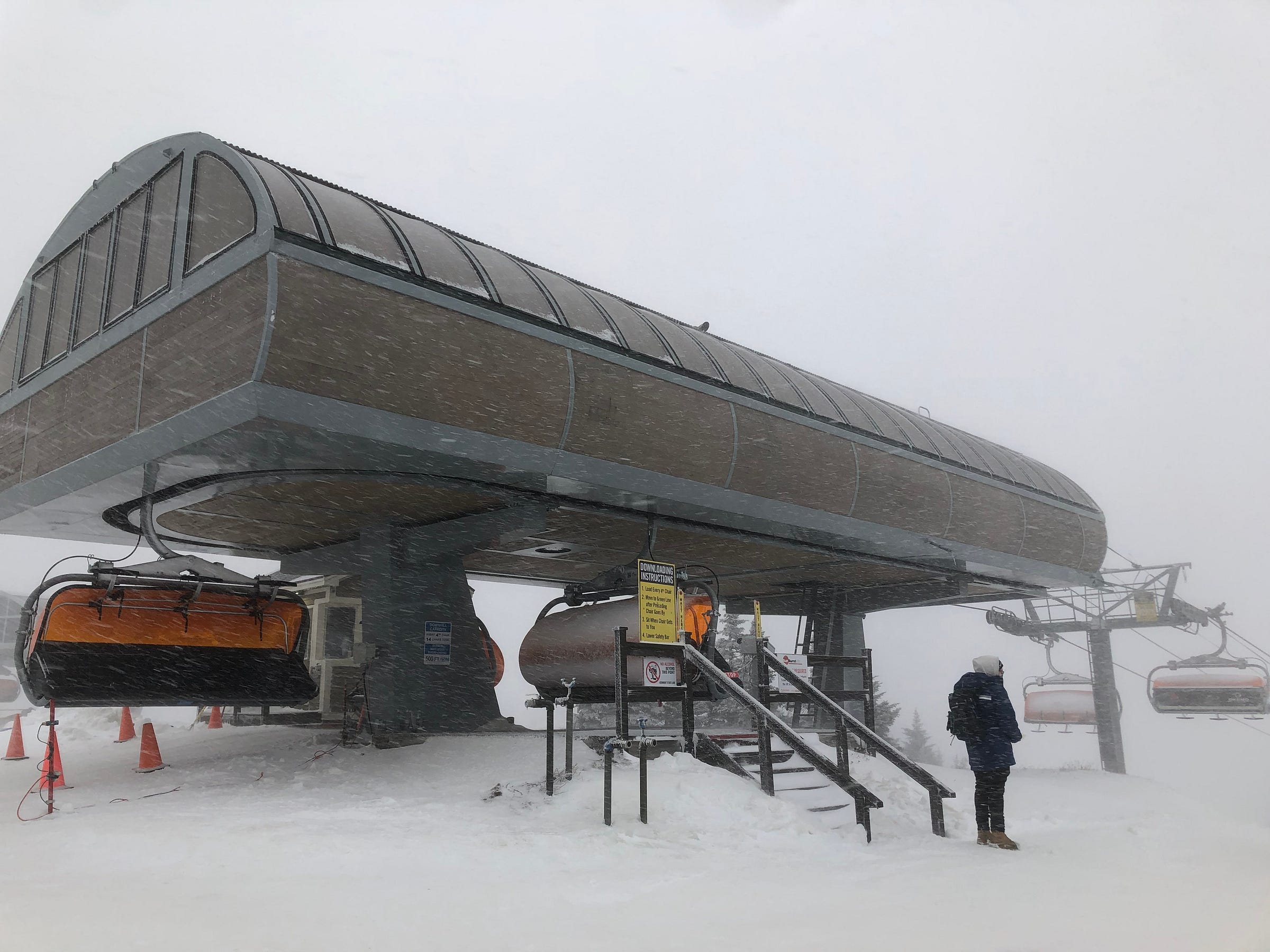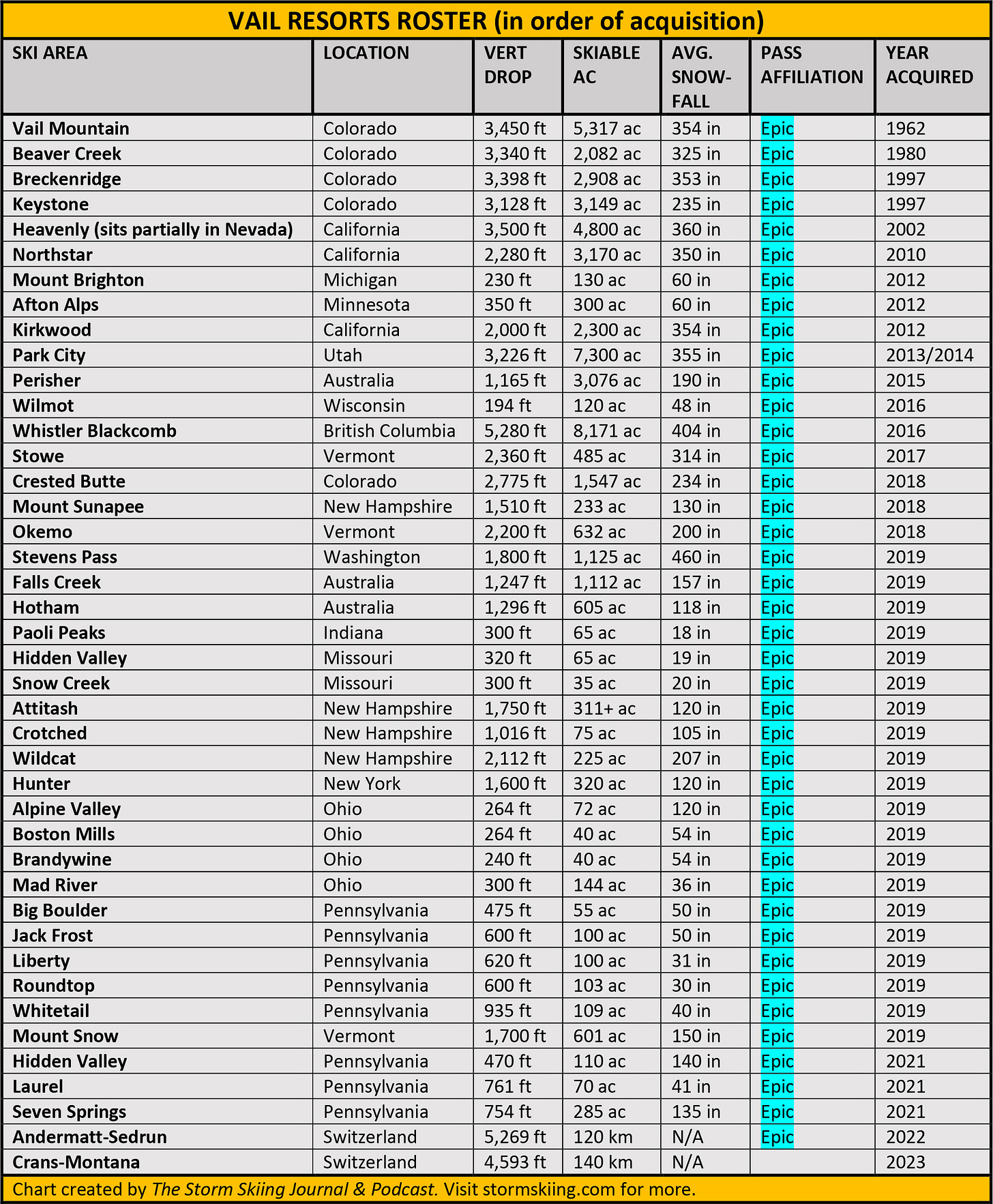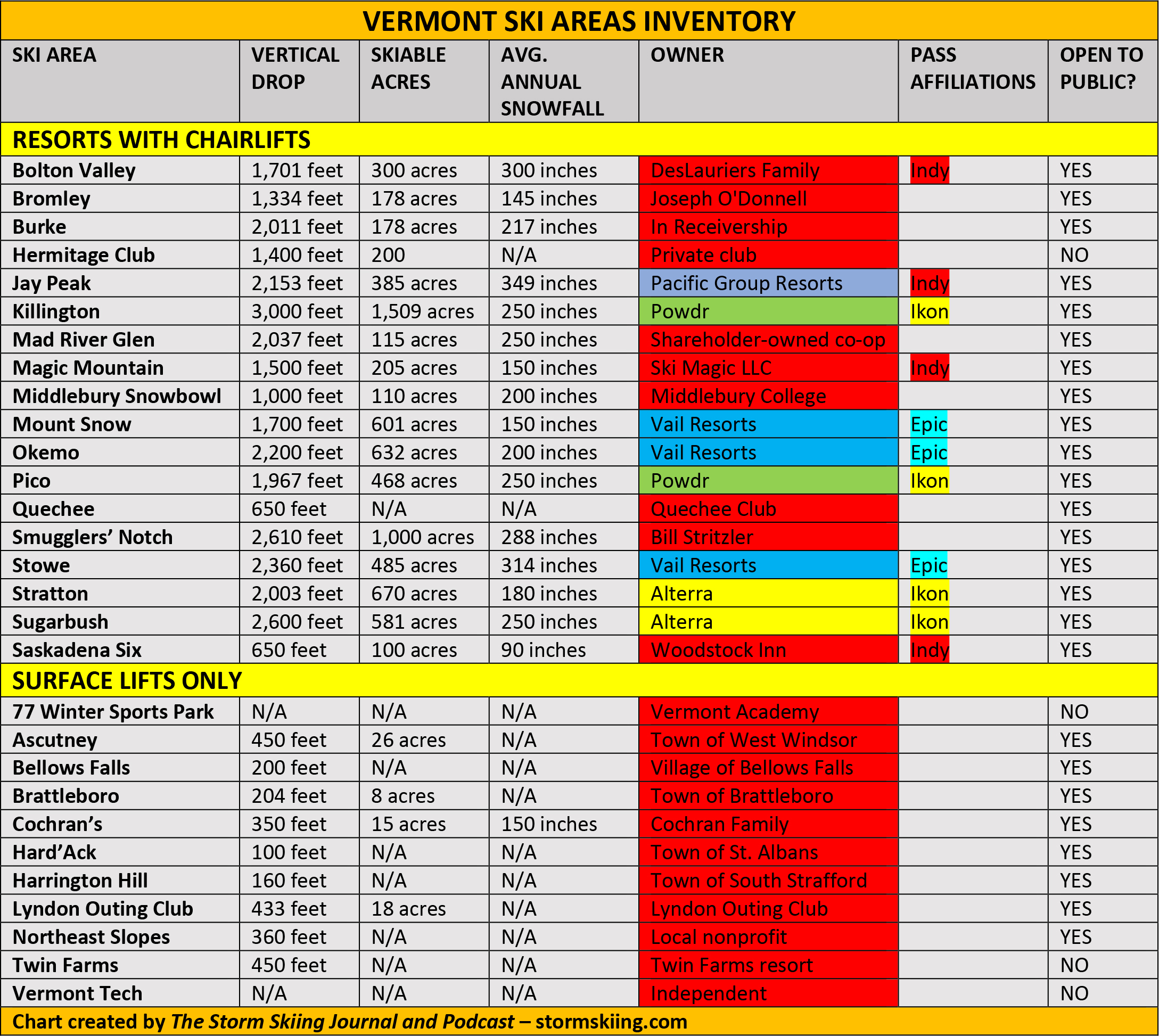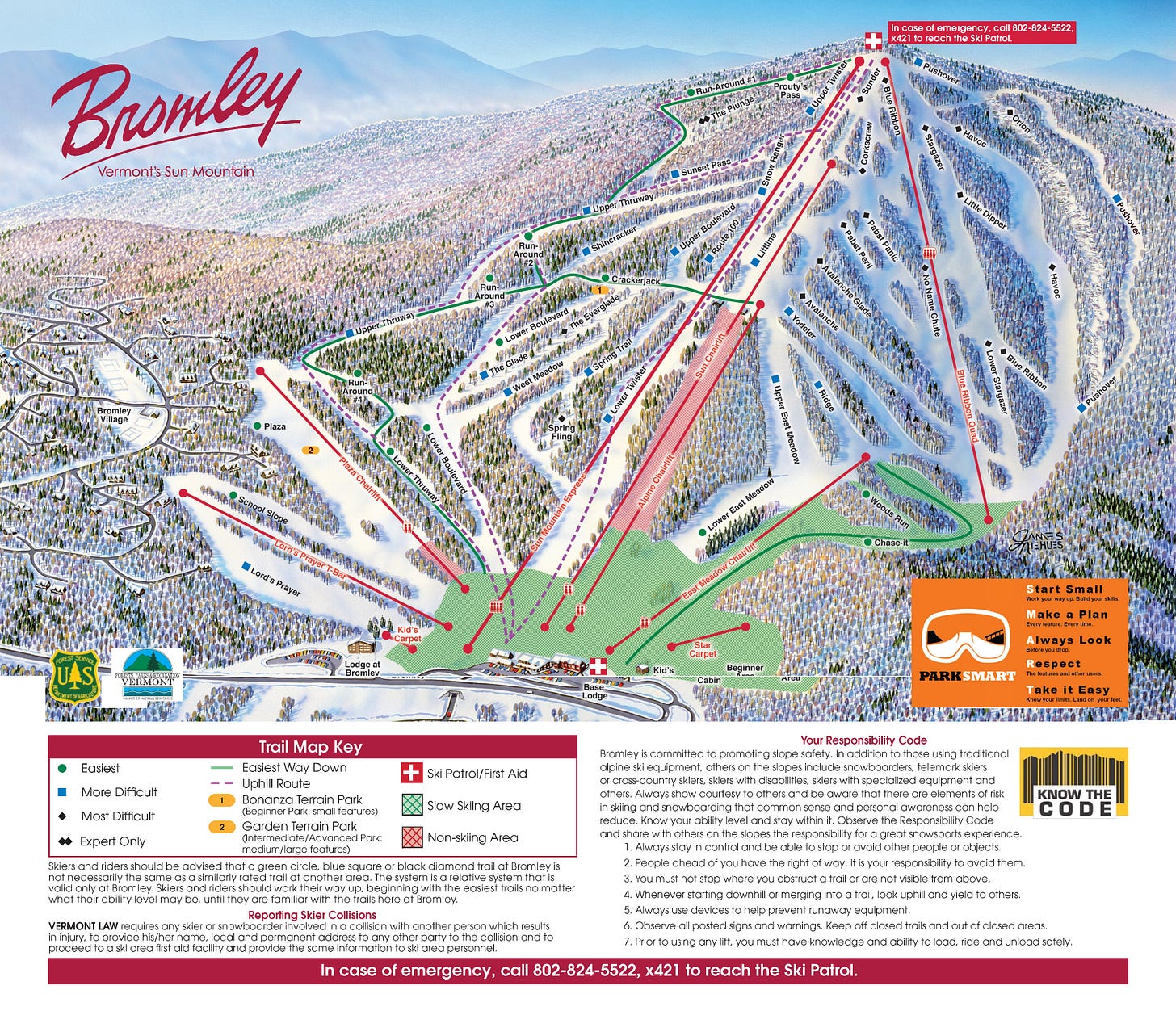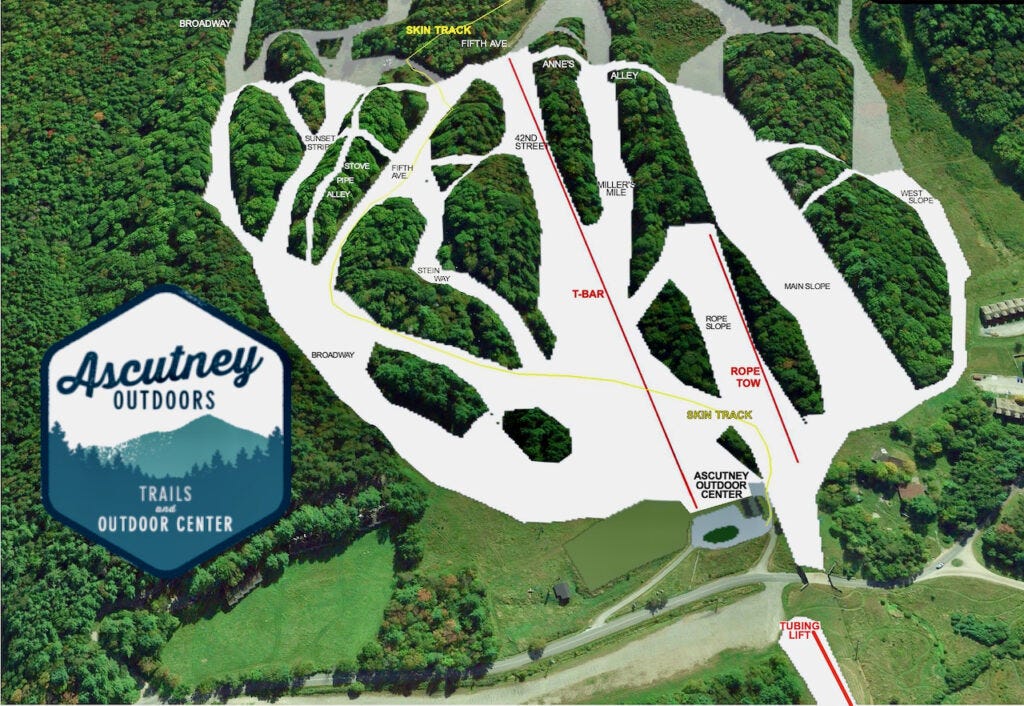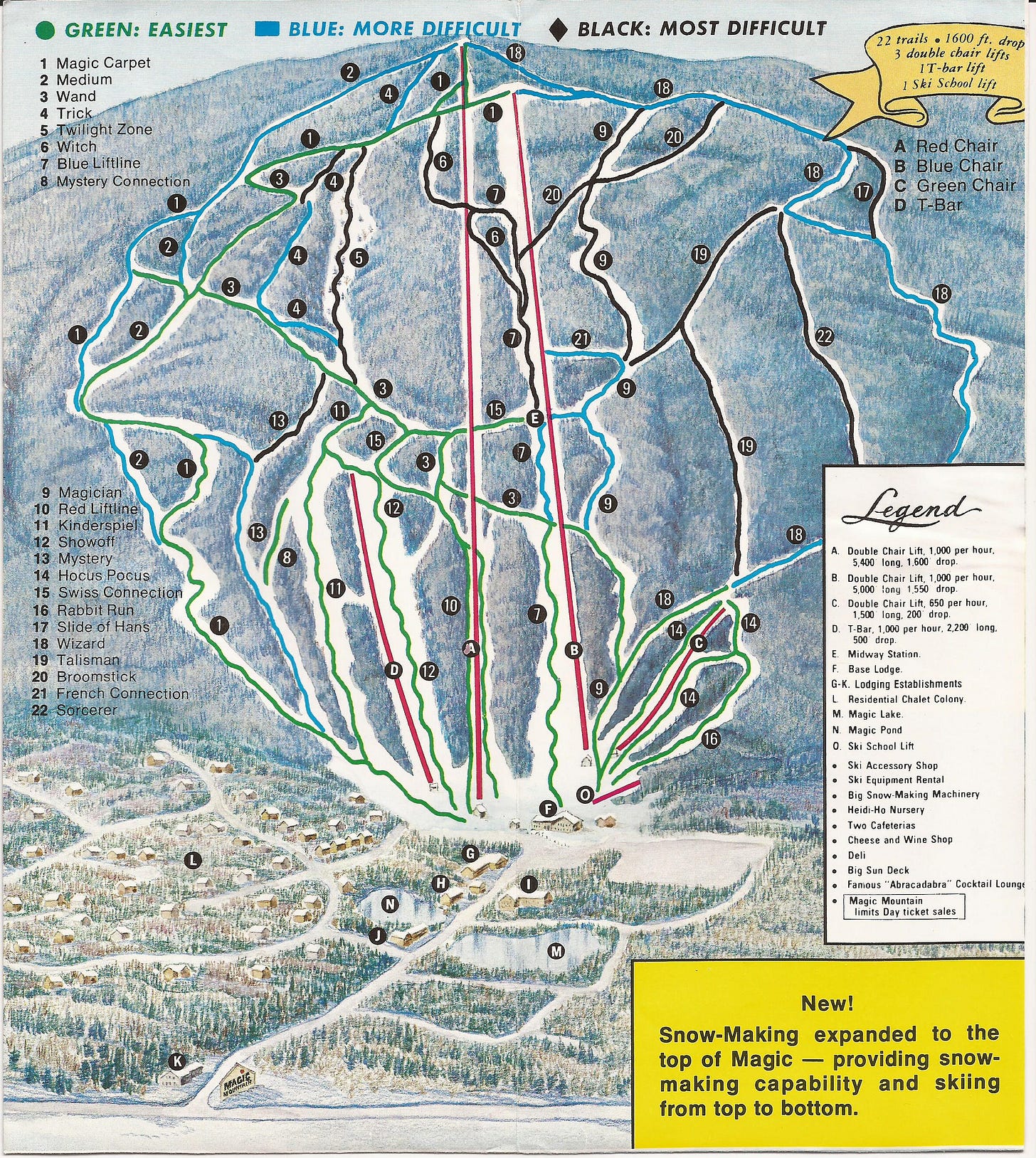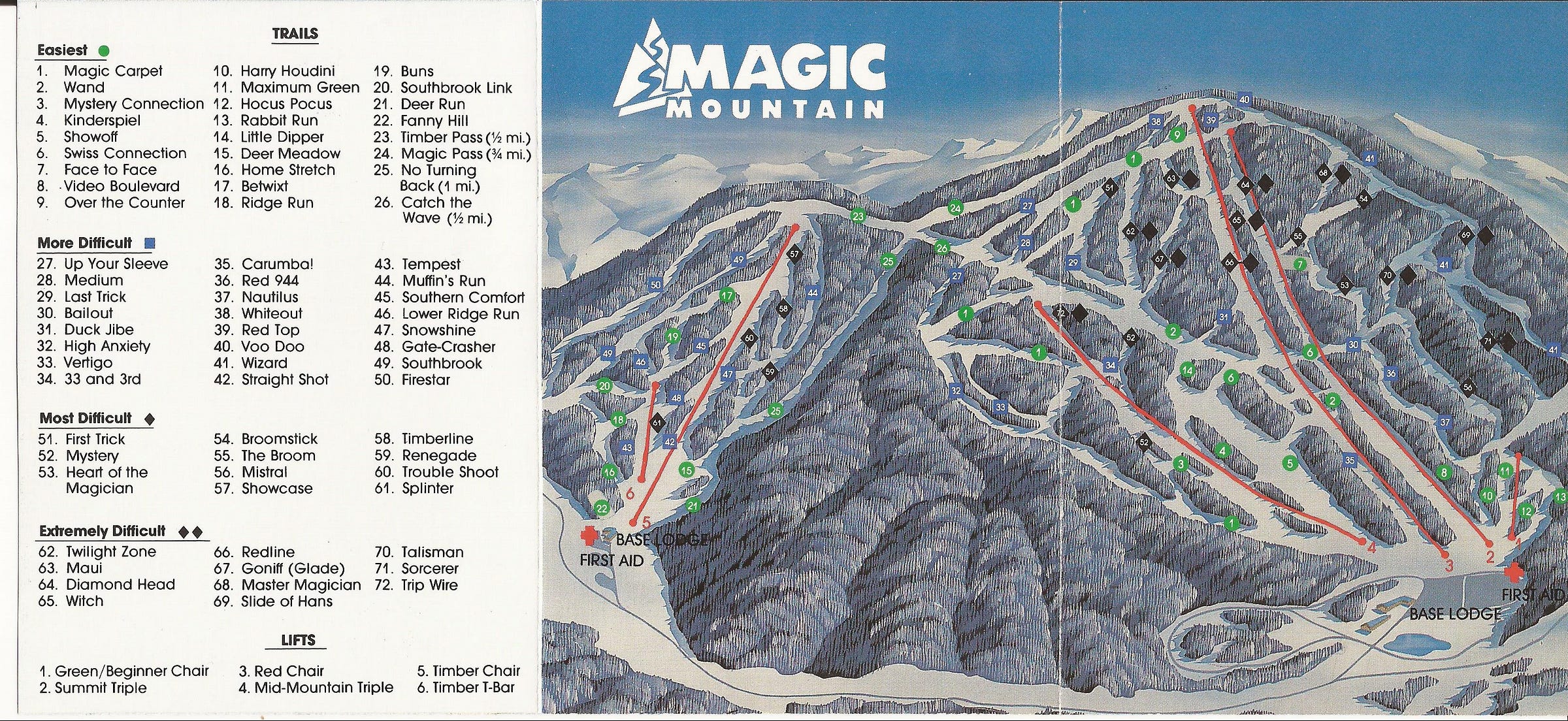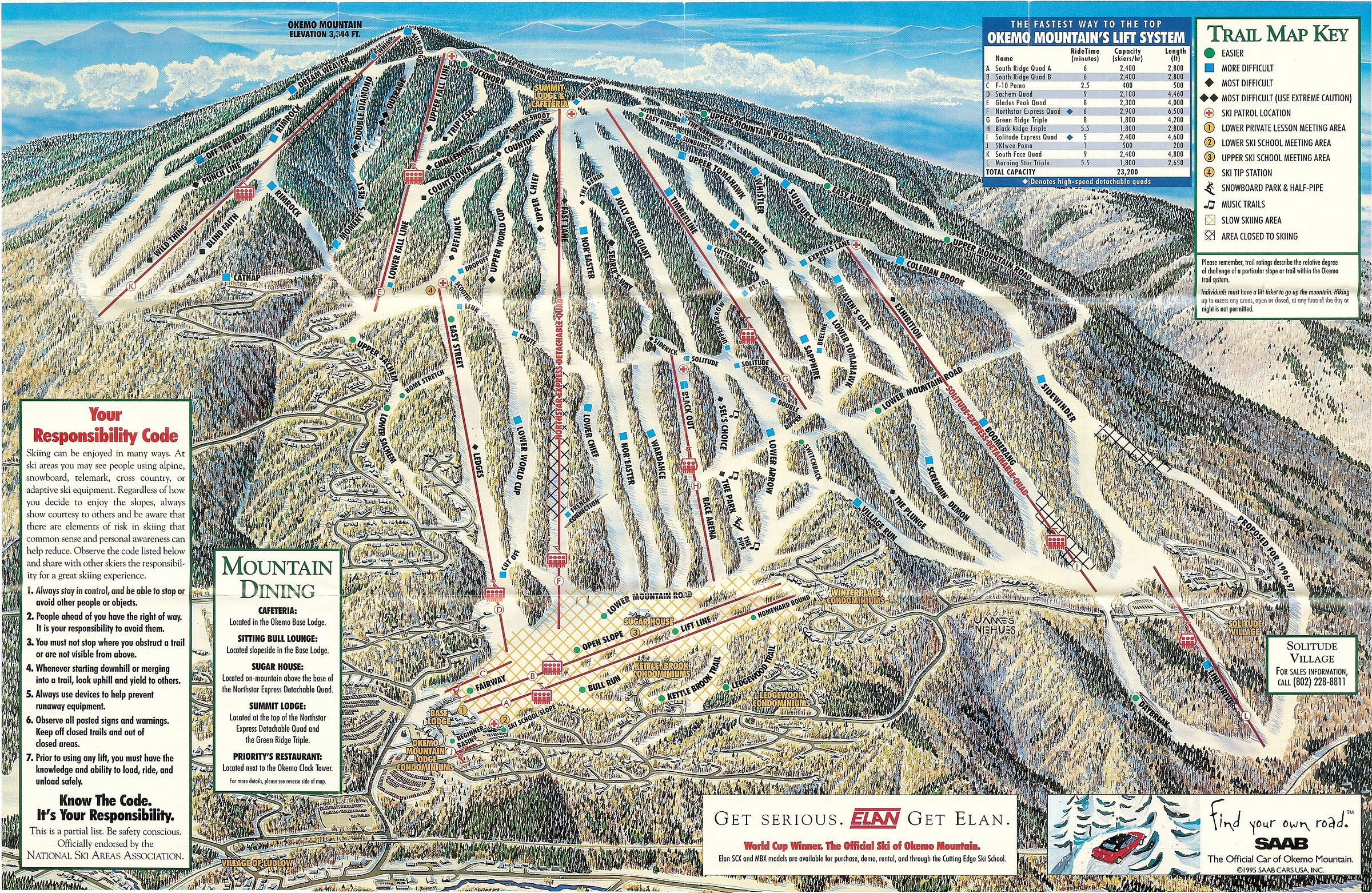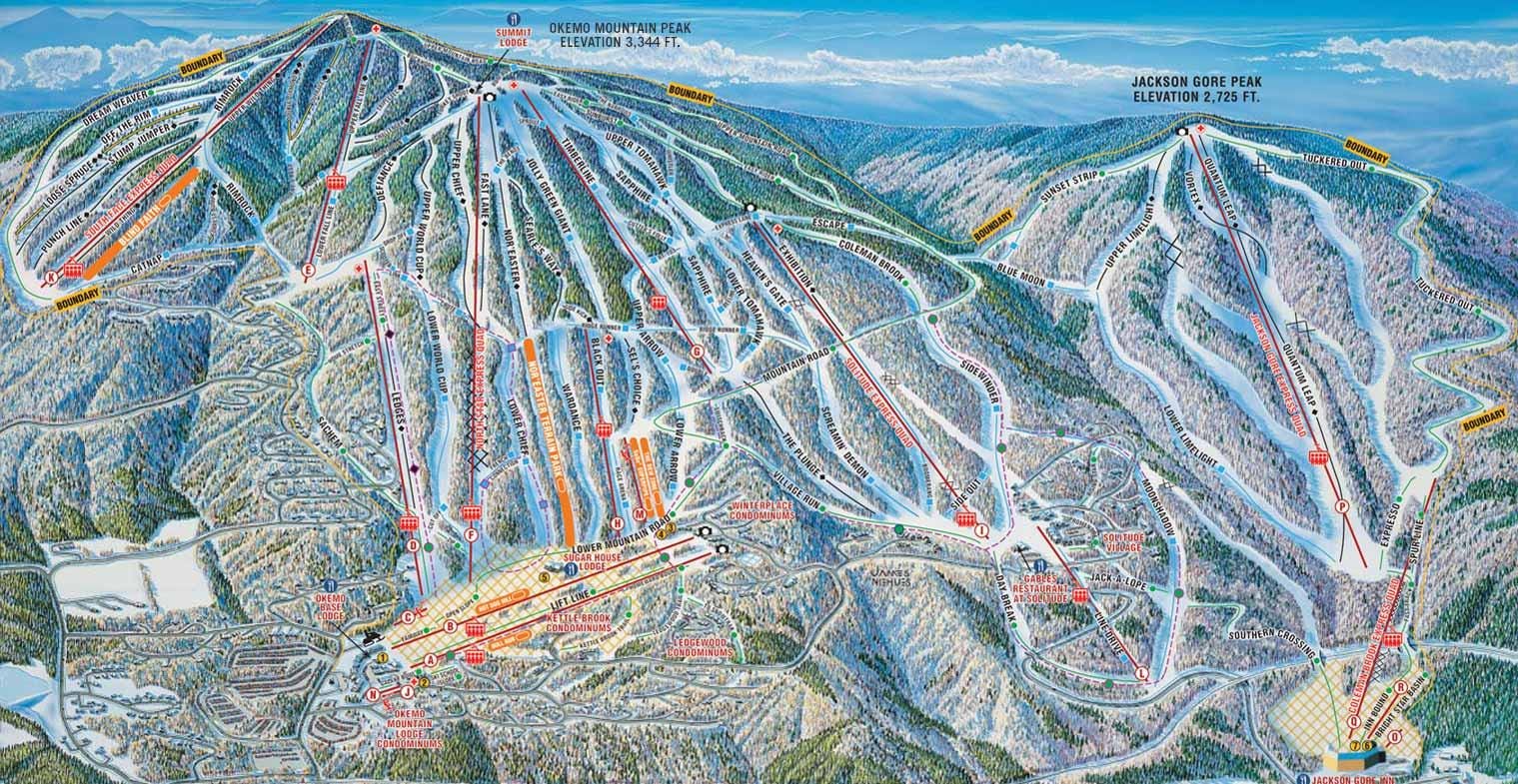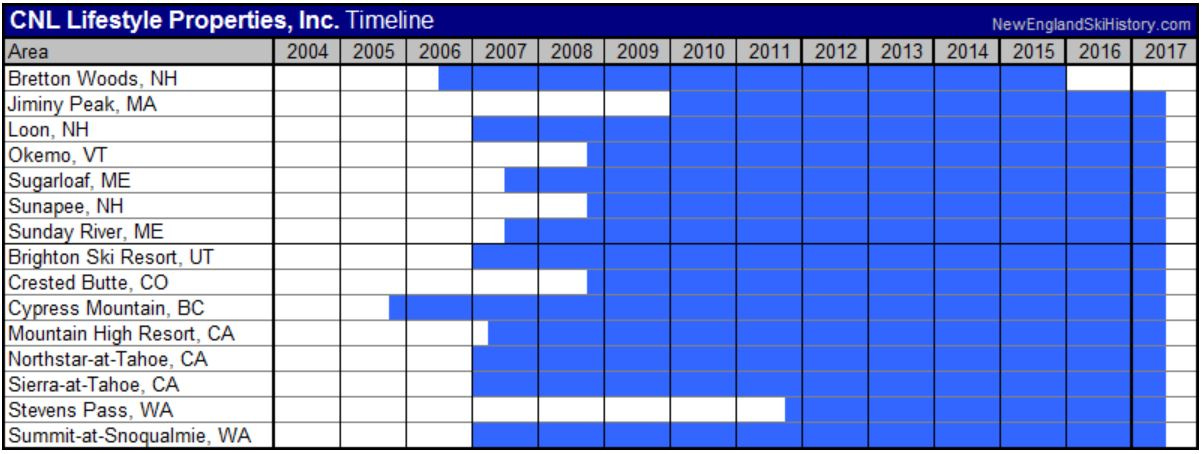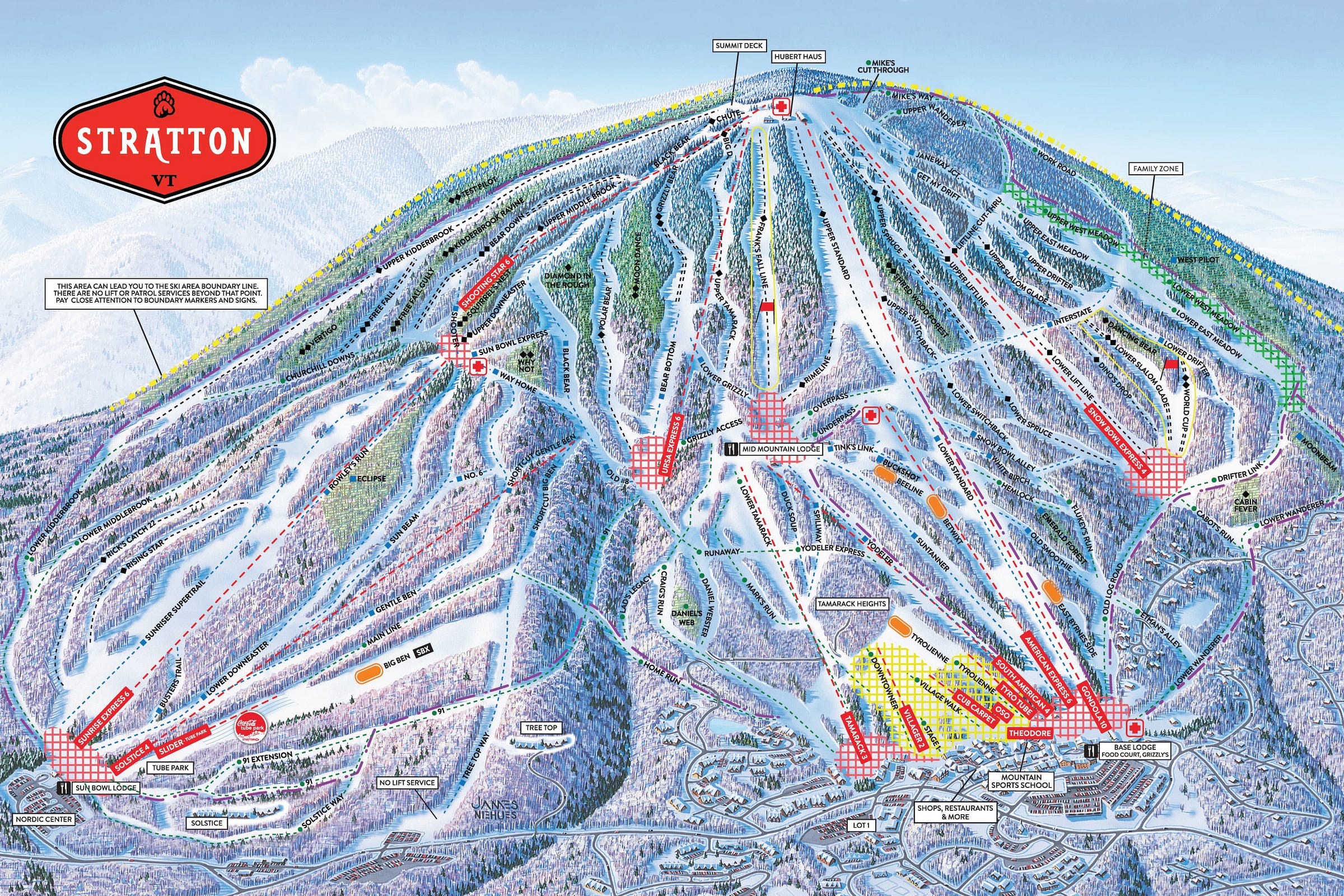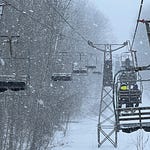Who
Bruce Schmidt, Vice President and General Manager at Okemo Mountain Resort, Vermont
Recorded on
Feb. 27, 2024 (apologies for the delay)
About Okemo
Click here for a mountain stats overview
Owned by: Vail Resorts
Located in: Ludlow, Vermont
Year founded: 1956
Pass affiliations:
Epic Pass: unlimited access
Epic Local Pass: unlimited access
Epic Northeast Value Pass: unlimited access with holiday blackouts
Epic Northeast Midweek Pass: unlimited weekday access with holiday blackouts
Epic Day Pass: access on “all resorts” and “32 resorts” tiers
Closest neighboring ski areas: Killington (:22), Magic (:26), Bromley (:31), Pico (:32), Ascutney (:33), Bellows Falls (:37), Stratton (:41), Saskadena Six (:44), Ski Quechee (:48), Storrs Hill (:52), Whaleback (:56), Mount Snow (1:04), Hermitage Club (1:10)
Base elevation: 1,144 feet
Summit elevation: 3,344 feet
Vertical drop: 2,200 feet
Skiable Acres: 632
Average annual snowfall: 120 inches per On The Snow; Vail claims 200.
Trail count: 121 (30% advanced, 37% intermediate, 33% beginner) + 6 terrain parks
Lift count: 20 (2 six-packs, 4 high-speed quads, 5 fixed-grip quads, 2 triples, 1 platter, 6 carpets – view Lift Blog’s inventory of Okemo’s lift fleet)
View historic Okemo trailmaps on skimap.org.
Why I interviewed him
Whether by plan or by happenstance, Vail ended up with a nearly perfect mix of Vermont ski areas. Stowe is the beater, with the big snows and the nasty trails and the amazing skiers and the Uphill Bros and the glades and the Front Four. Mount Snow is the sixth borough of New York City (but so is Florida and so is Stratton), big and loud and busy and bursting and messy, with a whole mountain carved out for a terrain park and big-drinking, good-timing crowds, as many skiers at the après, it can seem, as on the mountain. And Okemo is something that’s kind of in-between and kind of totally different, at once tame and lively, a placid family redoubt that still bursts with that frantic Northeast energy.
It's a hard place to define, and statistics won’t do it. Line up Vermont’s ski areas on a table, and Okemo looks bigger and better than Sugarbush or Stowe or Jay Peak. It isn’t, of course, as anyone in the region will tell you. The place doesn’t require the guts that its northern neighbors demand. It’s big but not bossy. More of a stroll than a run, a good-timer cruising the Friday night streets in a drop-top low-rider, in no hurry at all to do anything other than this. It’s like skiing Vermont without having to tangle with Vermont, like boating on a lake with no waves.
Because of this unusual profile, New England skiers either adore Okemo or won’t go anywhere near it. It is a singular place in a dense ski state that is the heart of a dense ski region. Okemo isn’t particularly convenient to get to, isn’t particularly snowy by Vermont standards, and isn’t particularly interesting from a terrain point of view. And yet, it is, historically, the second-busiest ski area in the Northeast (after Killington). There is something there that works. Or at least, that has worked historically, as the place budded and flourished in the Mueller family’s 36-year reign.
But it’s Vail’s mountain now, an Epic Pass anchor that’s shuffling and adding lifts for the crowds that that membership brings. While the season pass price has dropped, skier expectations have ramped up at Okemo, as they have everywhere in the social-media epoch. The grace that passholders granted the growing family-owned mountain has evaporated. Everyone’s pulling the pins on their hand grenades and flinging them toward Broomfield every time a Saturday liftline materializes. It’s not really fair, but it’s how the world is right now. The least I can do is get their side of it.
What we talked about
Summer storm damage to Ludlow and Okemo; the resort helping the town; Vermont’s select boards; New England resilience; Vail’s My Epic Promise fund and how it helped employees post-storm; reminiscing on old-school Okemo and its Poma forest; the Muellers arrive; the impact of Jackson-Gore; how and why Okemo grew from inconsequential local bump to major New England ski hill; how Okemo expanded within the confines of Vermont’s Act 250; Vail buys the mountain, along with Sunapee and Crested Butte; the Muellers’ legacy; a Sunapee interlude; Vail adjusting to New England operations; mythbusters: snowmaking edition; the Great Chairlift Switcheroo of 2021; why Okemo didn’t place bubbles on the Quantum 6; why Okemo’s lift fleet is entirely made up of Poma machines; where Okemo could add a lift to the existing trail network; expansion potential; does Okemo groom too much?; glade expansion?; that baller snowmaking system; what happened when Okemo’s season pass price dropped by more than $1,000; is Epic Pass access too loose at Okemo?; how to crowd-dodge; the Epic Northeast Midweek Pass; limiting lift ticket sales; and skyrocketing lift ticket prices.
Why I thought that now was a good time for this interview
Bruce Schmidt first collected a paycheck from Okemo in the late 1970s. That was a different mountain, a different ski industry, a different world. Pomas and double chairs and primitive snowmaking and mountain-man gear and no internet. It was grittier and colder, in the sense that snowpants and ski coats and heated gloves and socks were not so ubiquitous and affordable and high-quality as they are today. Skiing, particularly in New England, required a hardiness, a tolerance for cold and subtle pain that modernity has slowly shuffled out of the skier profile.
Different as it was, that age of 210s and rear-wheel drive rigs was not that long ago, and Schmidt has experienced it as one continuous story. That sort of institutional and epochal tenure is rare, especially at one ski area, especially at one that has evolved as much as Okemo. Imagine if you showed up at surface-lift Hickory and watched it transform, over four decades, into sprawling Gore. That’s essentially what Schmidt lived – and helped drive – at Okemo.
That hardly ever happens. Small ski areas tend to stay small. Expansion is hard and expensive and, in Vermont especially, bureaucratically challenging. And yet little Okemo, wriggling in Killington’s shadow, lodged between the state’s southern and northern snow pockets, up past Mount Snow and Stratton but not so far from might-as-well-keep-driving Sugarbush and Mad River Glen, became, somehow, the fourth-largest ski area in America’s fourth-largest ski state by skier visits (after Colorado, California, and Utah, typically).
The Mueller family, which owned the ski area from 1982 until they sold it to Vail Resorts in 2018, were, of course, the visionaries and financiers behind that growth, the likes of which we will probably never witness in New England again. But as Vail’s roots grow deeper and they make these mountains their own, that legacy will fade, if not necessarily dim. It was important, then, to download that part of Schmidt’s brain to the internet, to make sure that story survived the big groom of time.
What I got wrong
I said in the intro that Bruce started at Okemo in 1987. He actually started in the late ‘70s and worked there on and off for several years, as he explains in the conversation.
I said that Okemo’s lift fleet was “100 percent Poma.” This is not exactly right, as some of the lifts are officially branded Leitner-Poma. I’m also not certain of the make of Okemo’s carpets.
I noted in the intro that Okemo was Vail’s second-largest eastern mountain. It is actually their largest by skiable acreage (though Stowe feels larger to me, given the expansive unmarked but very skiable glades stuffed between nearly every trail). Here’s a snapshot of Vail’s entire portfolio for reference:
Why you should ski Okemo
The first time I skied Okemo was 2007. I rode a 3:45 a.m. ski bus north from Manhattan. I remember thinking three things: 1) wow, this place is big; 2) wow, there are a lot of kids here; and 3) do they seriously groom every goddamn trail every single night?
This was at the height of my off-piste mania. I’m not a great carver, especially after the cord gets chopped up and scratchy sublayers emerge. I prefer to maneuver, at a moderate pace, over terrain, meaning bumps or glades (which are basically bumps in the trees, at least on a typical Vermont day). It’s more fun and interesting than blasting down wide-open, beaten-up groomers filled with New Yorkers.
But wide-open, beaten-up groomers filled with New Yorkers is what Okemo is. At the time, I had no understanding of freeze-thaw cycles, of subtle snowfall differentials between nearby ski areas, of the demographic profile that drove such tight slope management (read: mediocre big-city skiers with no interest in anything other than getting to the bottom still breathing). All I knew was that for me, at the time, this wasn’t what I was looking for.
But what you want as a skier evolves over time. I still like terrain, and Okemo still doesn’t have as much as I’d like. If that’s what you need, take your Epic Pass to Stowe – they have plenty. But what I also like is skiing with my kids, skiing with my wife, morning cord laps off fast lifts, long meandering scenic routes to rest up between bumpers, exploring mountains border to border, getting a little lost among multiple base areas, big views, moderate pitches, and less-aggressive skiers (ride the K1 gondy or Superstar chair at Killington and then take the Sunburst Six at Okemo; the toning down of energy and attitude is palpable).
Okemo not only has all that – it is all that. If that makes sense. This is one of the best family ski areas in the country. It feels like – it is – a supersized version of the busy ski areas in Massachusetts or Connecticut, a giant Wachusett or Catamount or Mohawk Mountain: unintimidating, wide-open, freewheeling, and quirky in its own overgroomed, overbusy way.
If you hit it right, Okemo will give you bumps and glades and even, on a weekday, wide-open trails all to yourself. But that’s not the typical Okemo experience, and it’s not the point of the place. This is New England’s friendly giant, a meandering mass of humanity, grinning and gripping and slightly frazzled, a disjointed but united-by-snow collective that, together, define Okemo as much as the mountain itself.
Okemo on a stormy day in November 2021. Video by Stuart Winchester.
Podcast Notes
On last summer’s flooding in Okemo and Ludlow
I mean yowza:
I hate to keep harping on New Englander’s work ethic, but…
I reset the same “dang New England you’re badass” narrative that I brought up with Sunday River GM Brian Heon on the podcast a few weeks ago. I’m not from New England and I’ve never even lived there, and I’m from a region with the same sort of get-after-it problem-solver mentality and work ethic. But I’m still amazed at how every time New England gets smashed over the head with a frying pan, they just look annoyed for five minutes, put on a Band-Aid, and keep moving.
On the fate of Plymouth, Bromley, Ascutney, and Plymouth/Roundtop
Schmidt and I discuss several Vermont ski areas whose circa-1980s size rivaled that of Okemo’s at the time. Here, for context, was Okemo before the Muellers arrived in 1982:
It’s hard to tell from the trailmap, but only four of the 10 or so lifts shown above were chairlifts. Today, Okemo has grown into Vermont’s fourth-largest ski area by skiable acres (though I have reason to doubt the accuracy of the ski resort’s self-reported tallies; Stowe, Sugarbush, and Jay all ski at least as big as Okemo, but officially report fewer skiable acres).
Anyway, in the early ‘80s, Magic, Bromley, Ascutney, and Plymouth/Roundtop were approximate peers to Okemo.
Bromley ran mostly chairlifts, and has evolved the most of this group, but it is far smaller than Okemo today.
The mountain has always been well-managed, so it wasn’t entirely fair to stick it in with this group, but the context is important here: Bromley today is roughly the same size that it was 40 years ago:
Ascutney sold a 1,400-plus-foot vertical drop and a thick trail network in this 1982 trailmap. But the place went bust and sold its high-speed quad in 2012 (it’s now the main lift at Vail-owned Crotched).
Today, Ascutney consists of a lower-mountain ropetow and T-bar that rises just 450 vertical feet (you can still skin or hike the upper mountain trails).
Magic, in the early ‘80s, was basically the same size it is today:
A merger with now-private and liftless (but still skiable from Magic), Timber Ridge briefly supersized the place before it went out of business for a large part of the ‘90s:
When Magic recovered from its long shutdown, it reverted to its historic footprint (with extensive glade skiing that either didn’t exist or went unmarked in the ‘80s):
And then there was Round Top, a 1,300-foot sometime private ski area also known as Bear Creek and Plymouth Notch. The area has sat idle since 2018, though the chairlifts are, last I checked, intact, and it can be yours for $6.5 million.
Seriously you can buy it:
On Okemo’s expansion progression
The Muellers’ improbable transformation of Okemo into a New England Major happened in big chunks. First, they opened the Solitude area for the 1987-88 ski season:

In 1994, South Face, far looker’s left, opened a new pod of steeper runs toward the summit:

The small Morningstar pod, located in the lower-right-hand corner of the trailmap, opened in 1995, mostly to serve a real estate development:
The most dramatic change came in 2003, when Okemo opened the sprawling Jackson Gore complex:
On Vermont Act 250
It’s nearly impossible to discuss Vermont skiing without referencing the infamous Act 250, which is, according to the official state website:
…Vermont’s land use and development law, enacted in 1970 at a time when Vermont was undergoing significant development pressure. The law provides a public, quasi-judicial process for reviewing and managing the environmental, social and fiscal consequences of major subdivisions and developments in Vermont. It assures that larger developments complement Vermont’s unique landscape, economy and community needs. One of the strengths of Act 250 is the access it provides to neighbors and other interested parties to participate in the development review process. Applicants often work with neighbors, municipalities, state agencies and other interested groups to address concerns raised by a proposed development, resolving issues and mitigating impacts before a permit application is filed.
As onerous as navigating Act 250 can seem, there is significantly more slopeside development in Vermont than in any other Northeastern state, and its large resorts are certainly more developed than anything in build-nothing New York.
On the CNL lease structure
Schmidt refers to “the CNL lease structure.” Here’s what he was talking about: a company called CNL Lifestyle Properties once had a slick sideline in purchasing ski areas and leasing them back to the former owners. New England Ski History explains the historical context:
As the banking crisis unfolded, many ski areas across the country transferred their debt into Real Estate Investment Trusts (REITs). On December 5, 2008, Triple Peaks transferred its privately held Mt. Sunapee assets to CNL Lifestyle Properties, Inc.. Triple Peaks then entered into a long agreement with CNL to maintain operational control.
The site put together a timeline of the various resorts CNL once owned, including, from 2008 to ’17, Okemo:
On the proximity of Okemo to Mount Sunapee
Though Okemo and Sunapee sit in different states, they’re only an hour apart:
I snapped this pic of Okemo from the Sunapee summit a couple years ago (super zoomed in):

On Mount Sunapee’s ownership
The State of New Hampshire owns two ski areas: Cannon Mountain and Mount Sunapee. In 1998, after decades of debate on the subject, the state leased the latter to the Muellers. When Vail acquired Triple Peaks (Okemo, Sunapee, and Crested Butte), in 2019, they either inherited or renegotiated the lease. For whatever reason, the state continues to manage Cannon as part of Franconia Notch State Park. A portion of the lease revenue that Vail pays the state each year is earmarked for capital improvements at Cannon.
On glades at Stratton and Killington
Okemo’s trail footprint is light on glades compared to many of the large Vermont ski areas. I point to Killington and Stratton, in particular, in the podcast, mostly due to their proximity to Okemo (every Vermont ski area from Sugarbush on north has a vast glade network). Though it’s just 20 minutes away, Killington rakes in around double Okemo’s snowfall in an average winter, and the ski area maintains glades all over the mountain:
Stratton, 40 minutes south, also averages more snow than Okemo and is a sneaky good glade mountain. It’s easy to spend all day in the trees there when the snow’s deep (and it’s deep more often than you might think):
On Okemo’s historic pass prices
We can have mountain-to-mountain debates over the impact Vail Resorts has on the resorts it purchases, but one thing that’s inarguable: season pass prices typically plummet when the company acquires ski areas. Check out New England Ski History’s itemization of Okemo pass prices over the years – that huge drop in 2018-19 represents the ownership shift and that year’s cost of an Epic Local Pass (lift ticket and pass prices listed below are the maximum for that season):
But, yeah, those day-ticket prices. Yikes.
The Storm publishes year-round, and guarantees 100 articles per year. This is article 25/100 in 2024, and number 525 since launching on Oct. 13, 2019.





